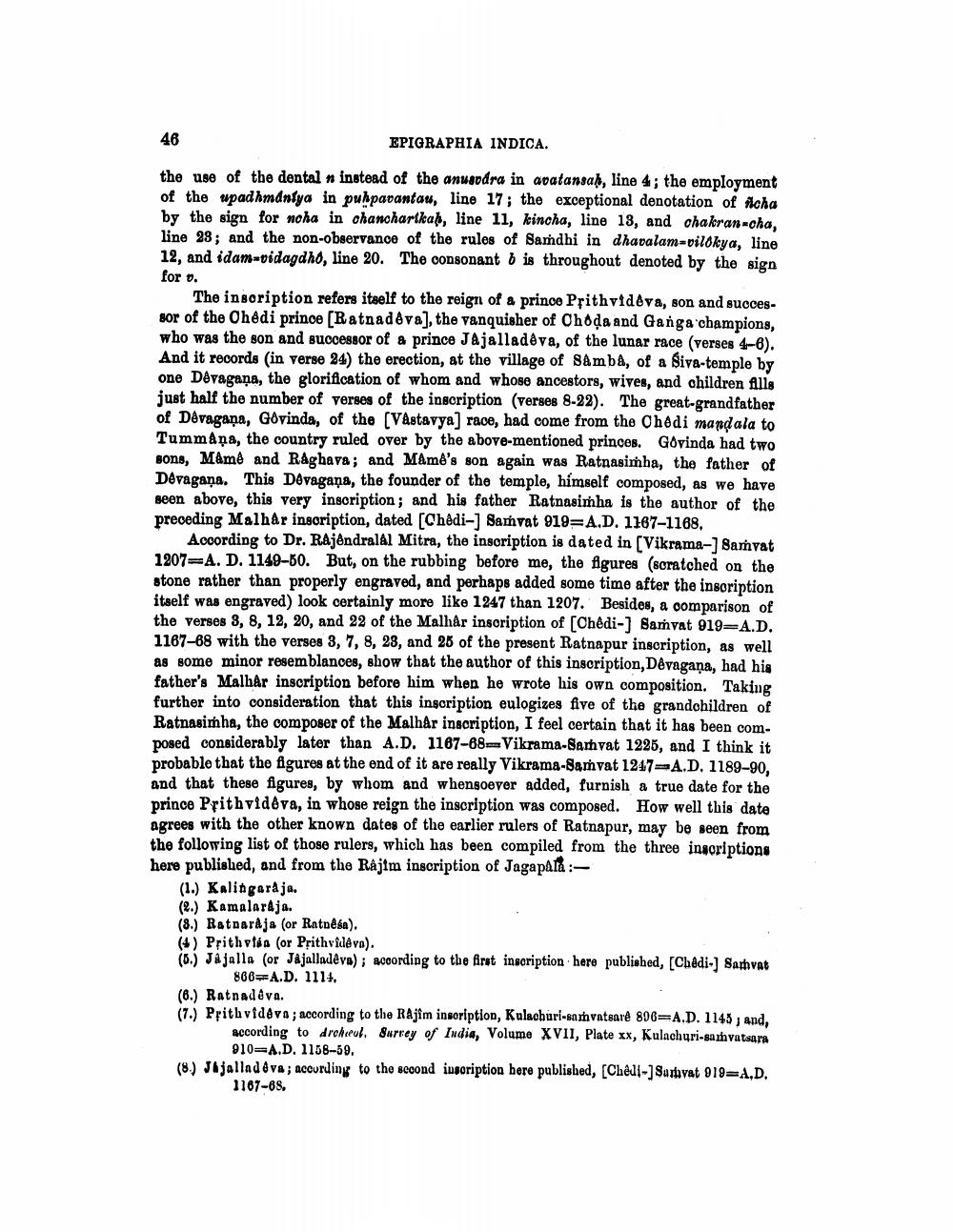________________
46
EPIGRAPHIA INDICA.
the use of the dental n instead of the anusddra in avatansah, line 4; the employment of the spadhmaniya in puhpavantau, line 17; the exceptional denotation of Acha by the sign for noha in chanchartkab, line 11, keincha, line 13, and chakran-cha, line 28; and the non-observance of the rules of Samdhi in dhavalam-viláky a, line 12, and idam-vidagdho, line 20. The consonant 6 is throughout denoted by the sign for o.
The insoription refers itself to the reign of a prince Prithvideva, son and successor of the Chedi prince (Ratnadeva], the vanquisher of Choda and Ganga champions, who was the son and successor of a prince Jajalladeva, of the lunar race (verses 4-6). And it records (in verse 24) the erection, at the village of Samba, of a Siva-temple by one Devagaña, the glorification of whom and whose ancestors, wives, and children Alle just half the number of verses of the inscription (verses 8-22). The great-grandfather of Devagaņa, Govinda, of the (Vastavya] race, had come from the Chodi mandala to Tummaņa, the country ruled over by the above-mentioned princes. Govinda had two sons, Mámé and Raghava; and Mame's son again was Ratnasimha, the father of Devagaņa. This Devagaña, the founder of the temple, hímself composed, as we have seen above, this very inscription; and his father Ratnasimha is the author of the preceding Malhar inscription, dated (Chêdi-] Samvat 919=A.D. 1167–1168,
According to Dr. Rajendralal Mitra, the inscription is dated in (Vikrama-] Samvat 1207=A. D. 1149-50. But, on the rubbing before me, the figures (scratched on the stone rather than properly engraved, and perhaps added some time after the insoription itself was engraved) look certainly more like 1247 than 1207. Besides, a comparison of the verses 3, 8, 12, 20, and 22 of the Malhar inscription of [Chêdi-) Samvat 919=A.D. 1167-68 with the verses 3, 7, 8, 28, and 25 of the present Ratnapur inscription, as well as some minor resemblances, show that the author of this inscription, Dévagana, had his father's Malhar inscription before him when he wrote his own composition. Taking further into consideration that this inscription eulogizes five of the grandchildren of Ratnasimha, the composer of the Malhar inscription, I feel certain that it has been composed considerably later than A.D. 1167-68=Vikrama-Samvat 1226, and I think it probable that the figures at the end of it are really Vikrama-8amvat 1247-A.D. 1189-90, and that these figures, by whom and whensoever added, furnish a true date for the prince Ppithvideva, in whose reign the inscription was composed. How well this date agrees with the other known dates of the earlier rulers of Ratnapur, may be seen from the following list of those rulers, which has been compiled from the three inscriptions here published, and from the Rajim inscription of Jagapata :
(1.) Kalingaraja. (2.) Kamalaraja. (8.) Ratnaraja (or Ratpêsa). (4) Přith visa (or Prithvideva). (.) JAjalla (or Jajalladeva); according to the first inscription here published, [Châdi-) Sathvat
860=A.D. 1114, (6.) Ratnadeva. (7.) Prithvidova; according to the RAjim insoription, Kulacburi-sath vatsare 806 A.D. 1145, and,
according to drohul. Survey of India, Volume XVII, Plate xx, Kulachuri-samvatsara
910-A.D. 1158-59. (8) Jajalladova; according to the second inscription bere published, (Chell-) Surovat 019=A,D.
1167-68.




